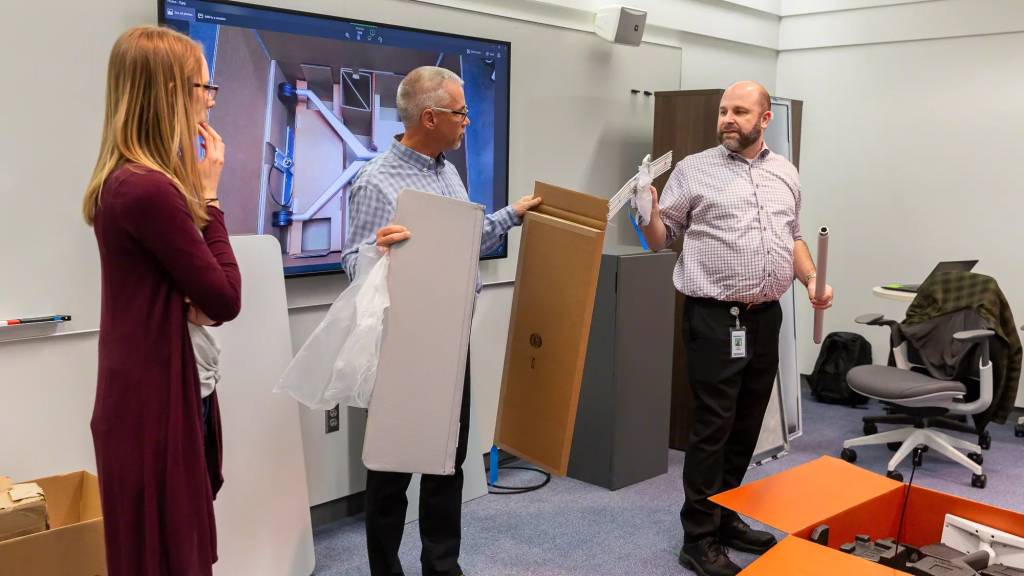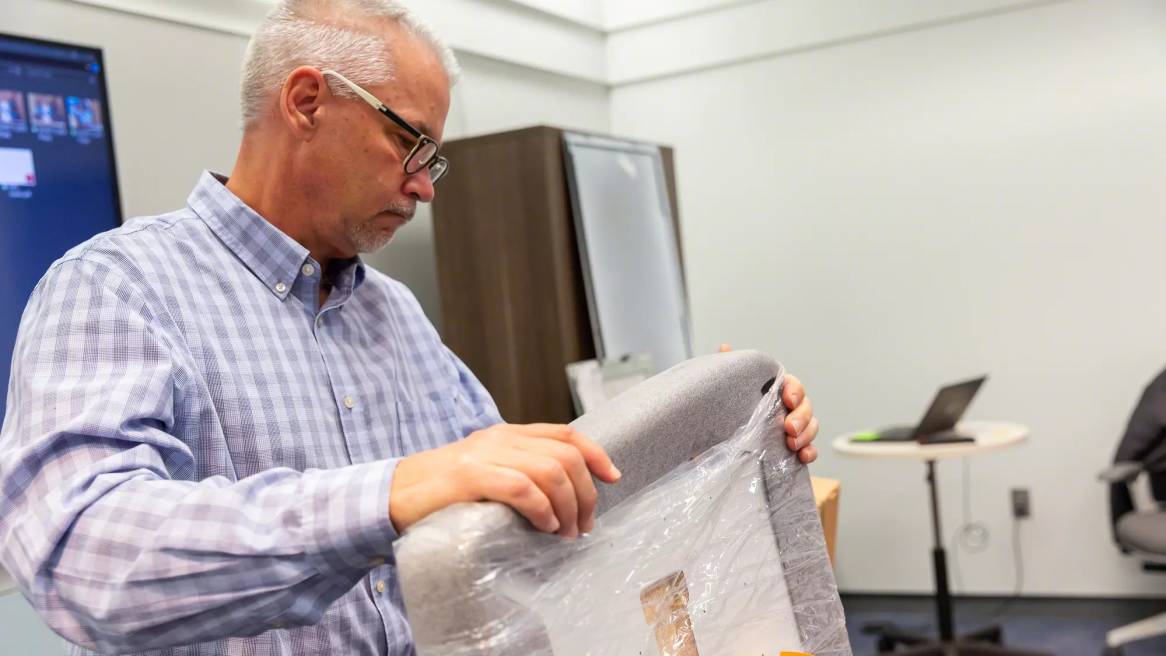Hack the Pack
A cross-functional Steelcase workshop addresses sustainability in packaging
Does this sound familiar? A package is delivered to your doorstep with something you ordered. After opening the cardboard box, you find the product wrapped with plastic straps around brown-paper protective cushioning, surrounded by plastic bubbles. Maybe there’s styrofoam or packing peanuts as well.
And that’s before the product’s actual packaging: plastic film, more cardboard and tags to cut. Sometimes, if the product is breakable, it might even be broken.
The box needs to be broken down, with all tape removed. The other materials need to be sorted into the recycling and garbage bins for the weekly pickup; the plastic needs to be collected separately to take to plastic bag drop-off stations. Often, after all that labor, if you’re honest, most of it just goes into the trash anyway.
Consumers know, and now companies are realizing that it’s as important to design the packaging as what’s inside.

In February of 2020, a team of cross disciplinary groups gathered together to better understand how they could improve packaging for selected products based on quality, sustainability and distribution concerns. The concept was developed to determine if there were opportunities to continue to improve packaging in a way that would most impact the planet and Steelcase customers. That idea evolved into a workshop they called “Hack the Pack.”
Experts from Distribution, Packaging, Sustainability, Quality and even some Steelcase dealers came together in Grand Rapids, Mich., to unpack the nominated products and discuss packaging design, packaging materials, packaging waste and disposal options for each product. These discussions led to an identification of the most relevant opportunities to innovate product packaging. They made notes about the packaging experience – determining what was and wasn’t working and what could be improved – before holding a vote on the top four products they felt could have the most significant impacts to help prioritize their work for the year ahead.
“How many types of packaging materials did each product use?” they asked themselves. “How expensive were those materials?” “How much really ended up in a recycling plant versus a landfill?”
Steelcase isn’t alone in thinking about designing for recycling. Recently, Ikea changed how its Ektorp sofa shipped, splitting it into several different parcels, which reduced packaging by half and saved about $1.4 million a year. Another company that sells frozen pizza shrunk its pizza-box dimensions by a miniscule measurement and saved over $600,000 a year. Well-designed packaging has positive effects on almost everything: conservation of resources; reduction in material; less storage and handling; less fuel and reduced emissions; minimization of waste at the consumer level; and better protection of the product at the point of the consumer opening.
Steelcase has been recognized by “Newsweek” as one of America’s most responsible companies, due to its commitment to environmental stewardship, social impact and corporate governance—but there’s always more work to do. Steelcase recently announced achieving carbon neutrality and set an aggressive goal to further reduce greenhouse gas emissions aligned with climate science by 2030, positioning the company to go beyond net zero.
Steelcase is committed to working cross functionally to develop solutions to investigate and implement more environmentally-friendly materials to phase out single-use plastics in packaging. We also understand that putting more recycled content in our own packaging helps to drive the recycling economy, and that is why we are striving to have 100% recycled content in substantially all single-use packaging.
In Europe, the company’s environmental divisions are racing to stay ahead of European packaging regulations. Erich Craciun, a Steelcase engineering project manager in Munich, heard complaints from dealers and clients of overflowing garbage bins during installations, specifically from unpacking Ology worksurfaces. He calculated that each worksurface used eight feet of foam, 25 feet of stretch wrap, four plastic corner protection caps, and took four minutes to unpack. Instead of just asking for a reduction of the packing already in place such as thinner foam, Craciun is pushing for something entirely different: U-profiles, made of 100% recycled linerboard, which are adhered or strapped to a product. When unwrapped, the intuitive packaging drops from the product to the floor, Craciun says, “like a really good pot roast, the meat just falls from the bone.” The idea isn’t to do the same thing better; but to solve a problem by doing it in new ways.
Bulk packaging is another idea Craciun has implemented. Instead of hand loading and unloading eight pairs of legs, eight Ology work surfaces and eight connectors — each wrapped separately — what if all the parts came in one palletized pack? Loading and unloading a full trailer was reduced from about two hours to 30 minutes. The product quality is better preserved due to reduced handling and packaging is reduced, saving recycling costs. “I want everyone to think throughout the complete product life cycle,” Craciun says. “I call this design for recycling.”
While Craciun pushes for these and other changes, including reducing the use of plastic in the German market in two years, other countries are taking note. Colleagues in Spain and the Czech Republic are asking for his guidance and samples of his packaging idea. It’s time to research, explore and experiment with the boundaries of what’s possible in an area that many overlook.
Although not all the projects that came out of the Hack the Pack workshop are complete, progress is being made. Some highlights of the work so far include reducing over 13,000 pounds of wood per year in one pack and eliminating the need for EPP foam blocks in another pack, making it 99% cardboard and widely recyclable. These are just now being rolled out at the manufacturing plant. “It’s a win for Steelcase, win for the environment, win for the dealer,” says Casey Dupuie, operations lead for Steelcase’s carbon strategy and Hack the Pack organizer. These design changes save Steelcase $200,000 a year, eliminate single-use plastic foam blocks, and create more easily recyclable packs.
Attention is now on other products as teams are working to continue exploring new innovations in the packaging process. A few of the next projects on their list include:
- Creating bulk packs for screens with hopes of eliminating stretch wrap and foam.
- Investigating the opportunity and feasibility of stacking large sofas within overseas shipping containers to maximize cube space and reduce transportation emissions.
- Reducing single-use plastic foam blocks on another Steelcase pack.
And soon, the team will bring together another hack-the-pack group to evaluate more products. As Craciun says, “When we’re saving money, saving the planet and making it easier for the client, then we’re winning on multiple fronts.”


